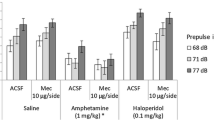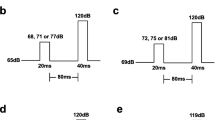Abstract
The modulatory role of serotonin (5-HT) on the acoustic startle reflex was studied using 5-HT receptor agonists and antagonists. 8-Hydroxy-2-(di-n-propylamino) tetralin (8-OHDPAT) (1,2 and 4 mg/kg, SC) and 5-methoxy-N,N-dimethyltamine (5-MeODMT) (1,2 and 4 mg/kg, IP), putative 5-HT1a receptor agonists, increased the magnitude of the startle reflex, while quipazine (5, 10 and 20 mg/kg, SC), an agonist with mixed 5-HT2 and 5-HT1b receptor activity, decreased startle responsiveness. Pretreatment of rats with ketanserin (1, 2 and 4 mg/kg, SC), a 5-HT2 receptor antagonist, had no significant effect on the activity of 8-OHDPAT, 5-MeODMT, or quipazine. Metergoline (0.25, 0.5, 1 and 2 mg/kg, SC), a mixed 5-HT1/5-HT2 receptor antagonist attenuated the augmentation of the reflex by 8-OHDPAT and 5-MeODMT and the suppression produced by quipazine. At the doses used, metergoline produced a non-dose-dependent increase in startle, while ketanserin had no effect. None of the agents specifically affected the bility of a prepulse stimulus to inhibit the acoustic startle response. These data suggest that 5-HT1a and 5-HT1b receptors play opposite roles in the modulation of the acoustic startle response and that 5-HT plays little, if any, role in the prepulse inhibition of the acoustic startle response.
Similar content being viewed by others
References
Bedard P, Pycock CJ (1977) “Wet-dog” shake behavior in the rat: a possible quantitative model of central 5-hydroxytryptamine activity. Neuropharmacology 16:663–670.
Blackburn TP, Kemp JD, Martin DA, Cox B (1984) Evidence that 5-HT agonist-induced rotational behaviour in the rat is mediated via 5-HT1 receptors. Psychopharmacology 83:163–165.
Commissaris RL, Davis M (1982) Opposite effects of N,N-dimethyltryptamine (DMT) and 5-methoxy-N,N-dimethyltryptamine (5-MeODMT) on acoustic startle: spinal versus brain sites of action. Neurosci Biobehav Rev 6:515–520.
Conn PJ, Sanders-Bush E (1987) Central serotonin receptors: effector systems, physiological roles and regulation. Psychopharmacology 92:267–277.
Corne SF, Pickering RW, Warner BT (1963) A method for assessing the effects of drugs on the central actions of 5-hydroxytryptamine. Br J Pharmacol 20:106–120.
Davis M (1987) Mescaline: excitatory effects on acoustic startle are blocked by serotonin2 antagonists. Psychopharmacology 93:286–291.
Davis M, Sheard MH (1974) Biphasic dose-response effects of n,n-dimethyltryptamine on the rat startle reflex. Pharmacol Biochem Behav 2:827–829.
Davis M, Astrachan DI, Kass E (1980a) Excitatory and inhibitory effects of serotonin on sensorimotor reactivity measured with acoustic startle. Science 209:521–523.
Davis M, Astrachan DI, Gendelman PM, Gendelman S (1980b) 5-Methoxy-N,N-dimethytryptamine: spinal and brainstem mediation of excitatory effects on acoustic startle. Psychopharmacology 70:123–130.
Davis M, Gendelman DS, Tischler MD, Gendelman PM (1982) A primary acoustic startle circuit: lesion and stimulation studies. J Neurosci 2:791–805.
Davis M, Cassella JV, Wrean WH, Kehne JH (1986) Serotonin receptor subtype agonists. differential effects on sensorimotor reactivity measured with acoustic startle. Psychopharmacol Bull 22:837–843.
Fechter LD (1974) Central serotonin involvement in the elaboration of the startle reaction in rats. Pharmacol Biochem Behav 2:161–171.
Fuller RW, Snoddy HD, Clemens JA (1978) The effect of quipazine, a serotonin agonist, on serum corticosterone concentration in rats. Endocrine Res Commun 7:77–85.
Grabowska M, Antkiewicz L, Michaluk J (1974) The influence of quipazine on the turnover rate of serotonin. Biochem Pharmacol 23:3211–3212.
Green AR, Youdim MBH, Grahame-Smith DG (1976) Quipazine: its effects on rat brain 5-hydroxytryptamine metabolism, monoamine oxidase and activity and behaviour. Neuropharmacology 15:173–179.
Haigler HJ, Aghajanian GK (1974) Lysergic acid diethylamide and serotonin: a comparison of effects on serotonergic neurons and neurons receiving a serotonergic input. J Pharmacol Exp Ther 188:688–699.
Harvey JA (1974) Physiological and pharmacological analysis of behavior. Adv Behav Biol 12:125–174.
Herr DW, Gallus JA, Tilson HA (1987) Pharmacological modification of tremor and enhanced acoustic startle by chlordecone and p,p′-DDT. Psychopharmacology 91:320–325.
Hjorth S, Carlsson A, Lindberg P, Sanchez D, Wikstrom H, Arvidsson LE, Hacksell U, Nilsson JLG (1982) 8-Hydroxy-2-(di-n-propylamino)tetralin, 8-OHDPAT, a potent and selective simpified ergot congener with central 5-HT receptor stimulating activity. J Neural Transm 55:169–188.
Hoffman HS, Ison JR (1980) Reflex modification in the domain of startle I. Some empirical findings and their implications for how the nervous system processes sensory input, Psychol Rev 87:175–189.
Ison JR (1984) Reflex modification as an objective test for sensory processing following toxicant exposure. Neurobehav Toxicol Teratol 6:437–445.
Jacobs BL (1976) An animal behavioral model for studying central serotonergic synapses. Life Sci 19:777–786.
Leitner DS, Cohen ME (1985) Role of the inferior colliculus in the inhibition of acoustic startle in the rat. Physiol Behav 34:65–70.
Leitner DS, Powers AS, Stitt CL, Hoffman HS (1981) Midbrain reticular formation involvement in the inhibition of acoustic startle. Physiol Behav 26:259–268.
Leysen JE, Awouters F, Kennis L, Laduron PM, Vandenberk J, Janssen PAJ (1981) Receptor binding profile of R 41468, a novel antagonist at 5-HT2 receptors. Life Sci 28:1015–1022.
Lloyd KG, Bartholini G (1974) The effect of methiothepin on cerebral monoamine neurons. Adv Biochem Psychopharmacol 10:305–309.
Lucki I, Nobler MS, Frazer A (1984) Differential actions of serotonin antagonists on two behavioral models of serotonin receptor activation in the rat. J Pharmacol Exp Ther 228:133–139.
Malick JB, Doren E, Barnett A (1977) Quipazine-induced head-twitch in mice. Pharmacol Biochem Behav 6:325–329.
Martin LL, Sanders-Bush E (1982) The serotonin autoreceptor: antagonism by quipazine. Neuropharmacology 21:445–450.
McCall RB, Aghajanian GK (1979) Serotonergic facilitation of facial motoneuron excitation. Brain Res 169:11–27.
Meltzer HY, Fang VS, Paul SM, Kaluskar R (1976) Effect of quipazine on rat plasma prolactin levels. Life Sci 19:1073–1078.
Middlemiss DN, Fozard JR (1983) 8-Hydroxy-2-(di-n-propylamino)-tetralin discriminates between subtypes of the 5-HT1 recognition site. Eur J Pharmacol 90:151–153.
Miller RG (1966) Simultaneous statistical inference. McGraw-Hill, New York
Mokler DJ, Commissaris RL, Warner MR, Rech RH (1983) Blockade of the behavioral effects of lysergic acid diethylamide, 2,5-dimethoxy-4-methyl amphetamine, quipazine and lisuride by 5-hydroxytryptamine antagonists. J Pharmacol Exp Ther 227:557–562.
Peroutka SJ (1984) 5-HT1 receptor sites and functional correlates. Neuropharmacology 23:1487–1492.
Peroutka SJ (1985) Selective labeling of 5-HT1a and 5-HT1b binding sites in bovine brain. Brain Res 344:167–171.
Saitoh K, Shaw S, Tilson HA (1986) Noradrenergic influence on the prepulse inhibition of acoustic startle. Toxicol Lett 34:209–216.
Saitoh K, Tilson HA, Shaw S, Dyer RS (1987) Possible role of the brainstem in the mediation of prepulse inhibition in the rat. Neurosci Lett 75:216–222.
Samanin R, Bernasconi S, Quattrone A (1976) Antinociceptive action of quipazine: relation to contral serotonergic receptor stimulation. Psychopharmacology 46:219–222.
Samanin R, Bendotti C, Candelaresi G, Garattini S (1977) Specificity of serotonergic involvement in the decrease of food intake induced by quipazine in the rat. Life Sci 21:1259–1266.
Sills MA, Woolfe BB, Frazer A (1984) Determination of selective and non-selective compounds for the 5-HT1a and 5-HT1b receptor subtypes in rat frontal cortex. J Pharmacol Exp Ther 231:480–487.
Svensson L (1985) Effects of 8-OHDPAT, lisuride and some ergot-related compounds on the acoustic startle response in the rat. Psychopharmacology 85:469–475.
Svensson L, Ahlenius S (1983) Enhancement by the putative 5-HT receptor agonist 8-OH-2-(di-n-propylamino)tetralin of the acoustic startle response in the rat. Psychopharmacology 79:104–107.
Tricklebank MD, Neill J, Kidd EJ, Fozard JR (1987) Mediation of the discriminative stimulus properties of 8-hydroxy-2-(di-n-propylamino)tetralin (8-OHDPAT) by the putative 5-HT1a receptor. Eur J Pharmacol 133:47–56.
White SR, Neuman RS (1980) Facilitation of spinal motoneurone excitability by 5-hydroxytryptamine and noradranaline. Brain Res 185:1–9.
Winer BJ (1971) Statistical principles in experimental design. McGraw-Hill, New York
Author information
Authors and Affiliations
Rights and permissions
About this article
Cite this article
Nanry, K.P., Tilson, H.A. The role of 5HT1A receptors in the modulation of the acoustic startle reflex in rats. Psychopharmacology 97, 507–513 (1989). https://doi.org/10.1007/BF00439556
Received:
Accepted:
Issue Date:
DOI: https://doi.org/10.1007/BF00439556




